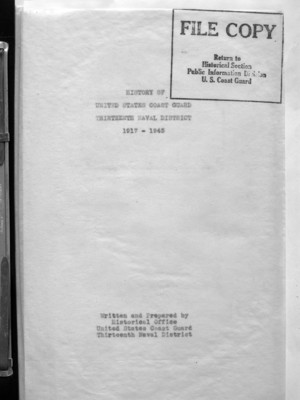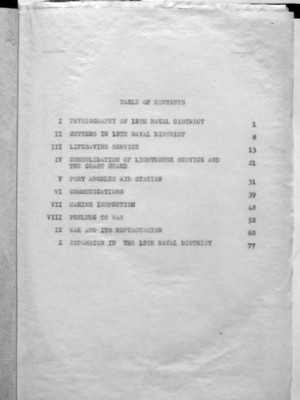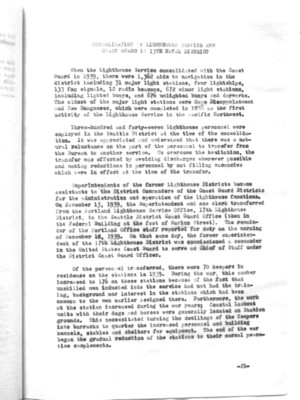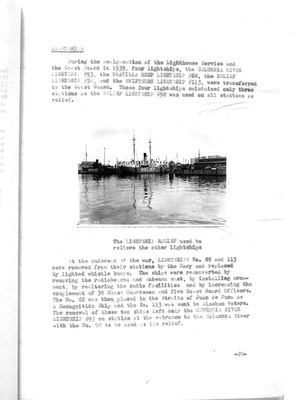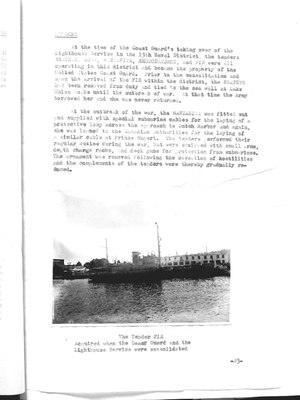Pages That Mention COAST GUARD
Coast Guard District narrative histories 1945
2
FILE COPY Return to Historical Section Public Information Division U. S. Coast Guard
HISTORY OF UNITED STATES COAST GUARD THIRTEENTH NAVAL DISTRICT 1917 - 1945
Written and Prepared by Historical Office United States Coast Guard Thirteenth Naval District
3
TABLE OF CONTENTS
I PHYSIOGRAPHY OF 13TH NAVAL DISTRICT 1 II CUTTERS IN 13TH NAVAL DISTRICT 8 III LIFESAVING SERVICE 13 IV CONSOLIDATION OF LIGHTHOUSE SERVICE AND THE COAST GUARD 21 V PORT ANGELES AND STATION 31 VI COMMUNICATIONS 39 VII MARINE INSPECTION 48 VIII PRELUDE TO WAR 52 IX WAR AND ITS REPERCUSSION 60 X EXPANSION IN THE 13TH NAVAL DISTRICT 77
4
CONSOLIDATION OF LIGHTHOUSE SERVICE AND COAST GUARD IN 13TH NAVAL DISTRICT
When the Lighthouse Service consolidated with the Coast Guard in 1939, there were 1,362 aids to navigation in the district including 31 major light stations, four lightships, 133 fog signals, 12 radio beacons, 672 minor light stations, including lighted buoys, and 676 unlighted buoys and daymarks. The oldest of the major light stations were Cape Disappointment and New Dungeness, which were completed in 1856 as the first activity of the Lighthouse Service in the Pacific Northwest.
Three-hundred and forty-seven Lighthouse personnel were employed in the Seattle District at the time of the consolidation. It was appreciated and understood that there was a natural reluctance on the part of the personnel to transfer from the Bureau to another service. To overcome the hesitation the transfer was effected by avoiding discharges whenever possible and making reductions in personnel by not filling vacancies which were in effect at the time of the transfer.
Superintendents of the former Lighthouse Districts became assistants to the District Commanders of the Coast Guard Districts for the administration and operation of the lighthouse functions. On November 13, 1939, the Superintendent and one clerk transferred from the Portland Lighthouse Service Office, 17th Lighthouse District, to the Seattle District Coast Guard Office (then in the Federal Building at the foot of Marion Street). The remainder of the Portland Office staff reported for duty on the morning of December 18, 1939. On that same day, the former superintendent of the 17th Lighthouse District was commissioned a commander in the United States Coast Guard to serve as Chief of Staff under the District Coast Guard Officer.
Of the personnel transferred, there were 70 keepers in residence on the stations in 1939. During the war, this number increased to 176 on these stations because of the fact that unskilled men inducted into the service had not had the training, background nor interest in the stations which had been common to the men earlier assigned there. Furthermore, the work at the station increased during the war years; Coastal Lookout units with their dogs and horses were generally located on Station grounds. This necessitated turning the dwellings of the Keepers into barracks to quarter the increased personnel and building kennels, stables and shelters for equipment. The end of the war began the gradual reduction of the stations to their normal peactime complements. -22-
5
During the amalgamation of the Lighthouse Service and the Coast Guard in 1939, four lightships, the COLUMBIA RIVER LIGHTSHIP 393, the UMATILLA REEF LIGHTSHIP #88, the RELIEF LIGHTSHIP #92, and the SWIFTSURE LIGHTSHIP #113, were transferred to the Coast Guard. These four lightships maintained only three stations as the RELIEF LIGHTSHIP #92 was used on all stations as relief.
(Photo of Relief Lightship displayed with caption below)
The LIGHTSHIP RELIEF used to relieve the other lighthships
At the outbreak of the war, LIGHTSHIPS No. 88 and 113 were removed from their stations by the Navy and replaced by lighted whistle buoys. the ships were reconverted by removing the radiobeacon and antenna mast, by installing armament, by realtering the radio facilities and by increasing the complement of 30 Coast Guardmen and five Coast Guard Officers. The No. 88 was then placed in the Straits of Juan de Fuca as a Recognition Ship and the No. 113 was sent to Alaskan Waters. The removal of these two ships left only the COLUMBIA RIVER LIGHTSHIP #93 on station at the entrance to the Columbia River with the No. 92 to be used as its relief.
-22-
6
At the time of the Coast Guard's taking over of the Lighthouse Service in the 13th Naval District, the tenders HEATHER, ROSE, MANZANITA, RHODODENDRON, and FIR were all operating in the district and became the property of the United States Coast Guard. Prior to the consolidation and upon the arrival of the FIR within the district, HEATHER had been removed from duty and tied to the sea wall at Lake Union Locks until the outbreak of war. At that time the Army borrowed her and she was never returned.
At the outbreak of the war, the MANZANITA was fitted out and supplied with special submarine cables for the laying of a protective loop across the approach to Dutch Harbor and again, she was loaned to the Canadian authorities for the laying of a similar cable at Prince Rupert. The tenders performed their regular duties during the war, but were equipped with small arms, depth charge racks, and deck guns for protection from submarines. The armament was removed following the cessation of hostilities and the complements of the tenders were thereby gradually reduced.
(Photo of the Tender Fir displayed here)
The Tender FIR Acquired when the Coast Guard and the Lighthouse Service were consolidated.
-23-
